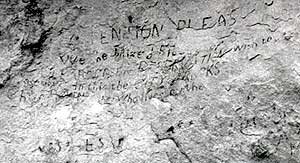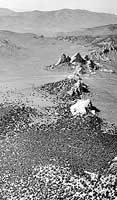|
Page
159
|

|
||
 |
||
| Writing by pioneers at Register Rock along the Oregon Trail in the City of Rocks, (September, 1987). |
The
California Trail
The California Trail
left the Oregon Trail and the Snake River west of the mouth of Raft River and
headed south and west toward the Nevada desert. It was joined by the Hudspeth
Cutoff near the town of Malta, on the west side of the Raft River Valley, and
the two wound up Connor Creek and south to the Silent City of Rocks. There,
a cutoff from Salt Lake City joined them, and a single trail led westward over
Granite Pass at the south end of Middle Mountain toward the Humboldt river drainage.
The
Almo Massacre: Folklore, not Fact
A recurring story
in the City of Rocks area is of the Almo Massacre, in which 300 Pioneers on
the California Trail were said to have been massacred by Indians in 1861. All
their stock and belongings were allegedly taken and nothing was left. The bodies
are said to have been buried in dry wells, and have never been found. This fable
has no basis in fact, was never reported in a newspaper account, nor does it
appear in any Pioneer diary (madsen, 1990). It is in the category of folklore,
since it is a story that keeps surfacing. As such it must be culturally useful
to those who hear and repeat it.
The
Albion Range and the Silent City of Rocks
The
Albion Range, including Mt. Harrison, Cache Peak, and the Silent City of Rocks
exposes a "Cordilleran metamorphic core complex," one of several that
extend from the Tucson, Arizona area north to northeastern Washington. The Silent
City of Rocks is an Idaho treasure. The mysterious fins and monoliths eroded
from the 30 million years old Almo Granite are perfect for rock climbing. A
walk along the South Fork of Circle Creek when the aspens are golden is an unforgettable
tour.
The upper part of the Albion Mountains is underlain by Paleozoic and Late Proterozoic metamorphic and sedimentary rocks, in places spectacularly folded, as along the road to the summit of Mount Harrison. The quartzites on the summit are structurally overturned. Below these is the green, micaceous Early Proterozoic Elba Quartzite, which can be seen in outcrops along the road below the Pomerelle ski area. South of Oakley thin-bedded micaceous quartzites including the Elba are quarried for decorative "Oakley stone," which is shipped throughout the United States and overseas. Under the Elba Quartzite is Archean gneiss and granite of the Green Creek Complex, exposed where the Mount Harrison road turns off Highway 22.
 |
| The Twin Sisters, looking north from the California Trail as it leaves the Silent City of Rocks, (October, 1992). |
The contact between the sedimentary rocks and the gneissic basement is a ductile fault or mylonite zone, the Middle Mountain Shear zone, produced during rapid uplift and stretching of the earth's crust from about 40 to 10 million years ago.
The bedrock in the Silent City of Rocks is an Oligocene granite pluton which cooled about 30 million years ago. The granite intrudes gneiss of the Green Creek Complex. The City of Rocks pluton is the youngest granitic body in Idaho. The rock is coarse-grained and unfoliated. It weathers into characteristic rounded monoliths and elongate fins controlled by systems of joints produced by unloading during uplift.
On the south edge of the City of Rocks, at the Twin Sisters, called the Sentinels or the Citadels by immigrants, just north of the California Trail, the contact between the 2400 million year Archean Green Creek Complex (South Sister) and the 30 million year Oligocene City of Rocks Granite (North Sister) can be seen.
A unique type of Oakley stone is the green micaceous quartzite seen on the front of many 20th century buildings in southern Idaho and northern Utah. The green color of this "Elba Quartzite" is given by a Chromium-bearing mica, fuchsite.